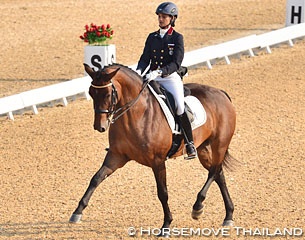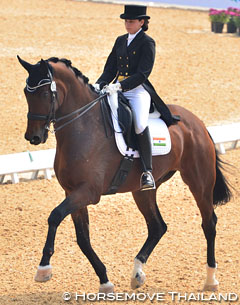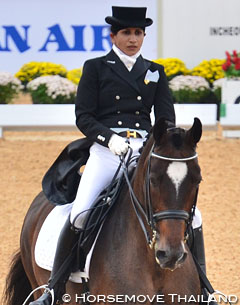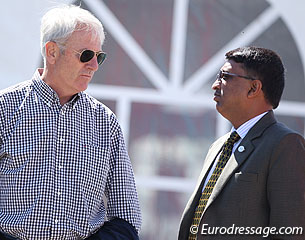
Dressage in India has come a long way. This rising dressage nation finished sixth at the 2014 Asian Games in Incheon (KOR) on 18 - 21 September 2014 where it gained its first international recognition as a developing dressage country. India's 3* judge Sunil Shivdas and the Indian team riders all consider this result very encouraging, particularly as it raises awareness for the country's potential as a dressage nation.
The stars on the Indian dressage firmament are Nadia Haridass, Vanita Malhotra, and Shubhsri Rajendra, spearheaded by national champion and the Asian Games highest ranked Indian Shruti Vora. India has only been a member of the FEI since 1971 and dressage has been considered the ugly duckling discipline due to its lack of adrenaline.
Shruti Vora Makes International Debut in Record Style
Finishing the individual championship in 9th place at the Asian Games, Shruti Vora is the Indian National Champion in all categories from novice up to Intermediaire I. Born into a family of industrialists, Shruti was definitely not destined for a life with horses.
“As you might be aware India is definitely not a horse country like you have in Europe, Germany, and the Netherlands, etc," Vora told Eurodressage. "However this is slowly changing and in recent years more and more people are importing warmbloods with the aim of improving the standard. In fact back in 1993 I was amongst the first private individuals, apart from the Indian army, to have imported a Dutch Warmblood into India.”
Happy with her individual ranking on her 13-year old Danish Warmblood mare Akira (by Akinos x Loran) which she acquired in Denmark as 2010 Asian Games' hopeful, Shruti became the highest ranked Indian rider ever at a continental Championship. Personally Shruti felt she messed up big time and was too ambitious in her kur.
“I made too many mistakes -- in fact in every tempi change -- and there are no excuses for doing badly, but if it is of any importance, in India we only have one dressage competition per year," she stated.
With little test practice and just four qualifying opportunities, the Indians faced further obstacles on their way to Incheon with tough quarantine procedures. However, at least in 2014 India was able to compete whereas in 2010 host country China refused India to participate Over the last three months before Incheon the team riders had to keep the horses in the temporary established Equine disease free zone in a small town in Meerut, where the ground conditions were rather pathetic .
“There was not even a proper dressage arena and with temperatures hovering between 40-45 degrees centigrae it was not the best preparation, not for the horses' emotional nor physical well being," Shruti admitted, even though she does not like to make excuses.
Her eighth individual place at the Asian Games after only five shows was an amazing feat nevertheless, adding that Shruti had never in fact ridden a freestyle before.
"The Kur in India is non existent and even for the qualifying trials there was not a chance to ride it. I was sure of my horse's capability though and had Joost Peters do my kur. While I was ok in the practice ring, when I actually entered I must have been tense and somehow passed it onto my mare. This is why we made so many mistakes in the tempi changes, something we usually do not do.”
Coached by Indian legend Major Jolly Ahlluwalia, Shruti calls her trainer the one and only good coach for dressage in India.
“Fortunately or unfortunately it's a one man show. This fact does have a negative impact within the riding fraternity in India but the fact remains that others who pretend to be trainers can't even get a 60 % at advanced level," said Shruti frankly. "At Prix St Georges and higher, apart from the four of us who went to the games, there is no one who can ride. Every single horse in India that has been ridden and competed at Prix St Georges level has been trained by Jolly.”
Taking advantage of his power position to determine the rules of the game on a national level, Jolly is the vice president of development for the Indian Equestrian Federation. He made the rule that only international FEI judges (3* or more) are allowed to judge in the country. Shruti actually agrees with this rule as part of the dressage development plan in her country.
"While this brought a lot of resistance in india, it is because of this very reason that someone like me, who with absolutely no competition exposure, has been able to ranked eighth in my very first international competition," Shruti stated.
Nadia Haridass, Training Internationally To Make it Big
 Second to come in for India, Nadia Haridass and 15-year old Dutch imported horse Toronto (by Jazz) finished 15th individually. To her the 2014 Asian Games were a good experience.
Second to come in for India, Nadia Haridass and 15-year old Dutch imported horse Toronto (by Jazz) finished 15th individually. To her the 2014 Asian Games were a good experience.
“My horse spooked in the Intermediaire I and also in the Kur so I lost marks due to that," Haridass told Eurodressage. "The inter I was going very, very well until the second canter pirouette in which he spooked and I made three mistakes from there on.”
The Bangalore based Haridass has been training with Hubertus Schmidt and Emma Kanerva in Paderborn, Germany, to prepare herself for her first major championships. Haridass says that renowned trainers refuse to come to India for clinics so the ambitious riders are forced to make their way to Europe if they want to get anywhere in the sport.
"Dressage in India is only just emerging and there are very few riders at small tour level. However I feel there is a lot of scope for dressage in India in the future," she said with high hopes.
Haridass' first coach was also Major Jolly Ahlluwalia.
"He is the best rider India has seen and apart from him, there is no one credible in this discipline," said Nadia. "Dressage in India is still int its formative stages and India is a country that loves action. Show jumping is more appealing to the public, which has almost zero knowledge of the sport. In time, I do believe dressage will gain popularity."
Visa Hurdles Along the Way
Shubhsri Rajendra and her 16-year old Smoky 249 (by Samico) was quite pleased with their 28th individual place, particularly as she was without her trainer at the Games.
"I have never really competed in India as I came to England to train after I started riding," said Rajendra. "At the Games the competitors were really friendly and helpful, most of them are based in Europe. Personally, I liked the Hong Kong team the best as they signed their national flag as a gift for me. The volunteers were nice and accommodating. For an adolescent, it was one of the most memorable times of my life.”
Because of Visa issuesShubhsri first had to go back to India from England and then to South Korea while her horse remained in quarantine in Germany with her groom.
 “Smoky is absolutely the most handsome piebald one can lay their eyes on," she said. "He is also the kindest, most patient and best school master I've ever known. I bought him from Bernadette Brune in France, who represents Germany in various CDI’s.”
“Smoky is absolutely the most handsome piebald one can lay their eyes on," she said. "He is also the kindest, most patient and best school master I've ever known. I bought him from Bernadette Brune in France, who represents Germany in various CDI’s.”
Trained by Vicki Thompson-Winfield of Oldencraig Equestrian Centre in Lingfield, U.K., Shubhsri says due to the harsh weather conditions she never really considered asking a trainer to come to India to help her.
“Finding trainers as good as the ones in Europe is very hard in India. Also, the quality of horses is not the same in India," said Rajendra. "In fact equestrian sports are not very common at all in India due to various reasons like cost, space, time, etc. Dressage is the least popular choice and faces a lot of stereotypes in India. The most prominent one is that it is just for girls because it does not provide the same level of exhilaration as jumping or eventing. I believe that breaking this will take quite a while," she said regrettably.
Vanita Malhotra Has Long Awaited Games Debut
For New Delhi based Vanita Malhotra, the fourth rider on the Indian team, competing at the 2014 Asian Games was a great experience and a long awaited one after having missed the 2010 edition due to veterinary protocol.
"I was relieved when my horse took off from Delhi to Incheon, because after last time I was taking nothing for granted. I felt that the standard of horses at the 2014 Asian Games had improved tremendously and the standards are really very high,” Vanita told Eurodressage.
 Riding one of the oldest horses at the event, Vanita bought her 19-year old Holsteiner gelding Cantaro in Austria in 2010. She is also trained by Jolly Ahlluwalia at her own farm.
Riding one of the oldest horses at the event, Vanita bought her 19-year old Holsteiner gelding Cantaro in Austria in 2010. She is also trained by Jolly Ahlluwalia at her own farm.
“You need to invest a lot in good quality horses, which I plan to," Malhotra explained. "In order to compete at this level and win a medal one has to be based in Europe and be competing regularly. Major Ahlluwalia has many horses in Germany and has breeding stallions. He is a mentor when it comes to riding and selecting a horse for purchase. I have a few younger horses in India which I plan to train and I also plan to purchase two horses in Germany, one younger one and an older one to compete there. I feel it is important to be in the heart of the competition world in order to do well at big events and make a mark."
Vanita believes that dressage is picking up in India, but the trainers are still an issue.
“We need good trainers and sponsors for the sport to pick up. Public awareness is required, many children from business homes are now taking up riding, but it’s not a mass sport like cricket," she said. "It is a sport for the elite as it is capital intensive. Also in India, the army is involved in this sport. Before there were hardly any civilian riders but now you see many civilian riders especially children taking up riding, but they give up at senior level due a lack of proper training.
Indian Judges, a two man show
Indian FEI 3* Judge Colonel Sunil Shivdas was not present at the Asian Games, but as a judge for India he is now in a position to pay it forward in a sport that has already given him so much.
"It gives me great pleasure imparting the knowledge I have to our riders, trainers and judges. I have taken a number of clinics so far and have judged extensively in South East Asia. The biggest challenge I now face is to get Grand Prix competitions to judge since they are few and far between in this region."
With only one other dressage judge from India, Col Dushyant Bali (FEI 2*) Sunil says it was indeed quite difficult to become a judge given his nationality.
 “In 2007 I embarked on my journey to become an FEI dressage judge. I had to spend a lot of time in Europe to do my sit-ins and shadow judging. In 2010 when I had met all the criteria to attend the exam for promotion to FEI Candidate judges, the FEI changed the criteria. Furthermore no exams were held in 2010. The new criteria was different for countries like India that did not have Grand Prix. So I had to begin qualifying all over again. In June 2011, at Gangeung, S Korea, I got my FEI 2* status. Now I was helped extensively by the FEI under the exchange programme for FEI officials. There are a number of senior judges who have helped me reach where I am but if I have to name a single person it would certainly be Mariette Withages who motivated me and steadfastly supported me all along.”
“In 2007 I embarked on my journey to become an FEI dressage judge. I had to spend a lot of time in Europe to do my sit-ins and shadow judging. In 2010 when I had met all the criteria to attend the exam for promotion to FEI Candidate judges, the FEI changed the criteria. Furthermore no exams were held in 2010. The new criteria was different for countries like India that did not have Grand Prix. So I had to begin qualifying all over again. In June 2011, at Gangeung, S Korea, I got my FEI 2* status. Now I was helped extensively by the FEI under the exchange programme for FEI officials. There are a number of senior judges who have helped me reach where I am but if I have to name a single person it would certainly be Mariette Withages who motivated me and steadfastly supported me all along.”
Hoping to get his 4* status by 2017, as a serving Army officer of the 61st Cavalry, Colonel Sunil plans to judge as much as his military duties permit him.
“On the home front a new series of dressage competitions called the 'Indian Dressage League' have been introduced, based on the FEI World Challenge format, judged by a single FEI dressage judge," said Shivdas. "This has served to bring back the focus onto dressage at all levels, and I feel that dressage In India has come a long way and its future is very promising.”
by Sarah Warne for Eurodressage - Photos © Horse Move Thailand - Astrid Appels
Related Links
Young Shik Hwang Claims Individual Gold at 2014 Asian Games
Scores: 2014 Asian Games
Thai Dressage Team On The Road to the 2014 Asian Games